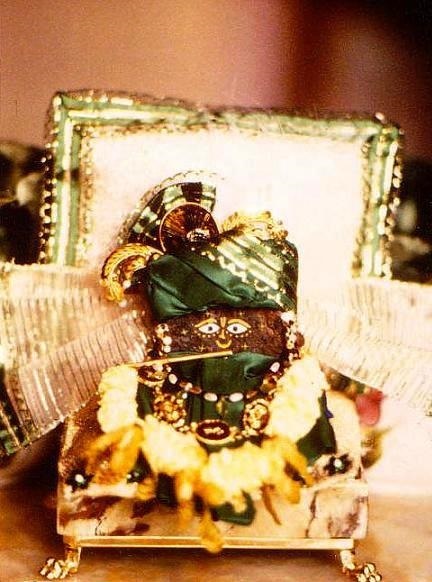(Sri Giridharilal, Cairo, Egypt 1980)
"The sacrifice known as Govardhana-pūjā is observed in the Kṛṣṇa consciousness movement. Lord Caitanya has recommended that since Kṛṣṇa is worshipable, so His land—Vṛndāvana and Govardhana Hill—is also worshipable. To confirm this statement, Lord Kṛṣṇa said that Govardhana-pūjā is as good as worship of Him. From that day, Govardhana-pūjā has been going on and is known as Annakūṭa. In all the temples of Vṛndāvana or outside of Vṛndāvana, huge quantities of food are prepared in this ceremony and are very sumptuously distributed to the general population."
(Kṛṣṇa Book, Chapter 24)
"The identity of Kṛṣṇa and Govardhana Hill is still honored, and great devotees take rocks from Govardhana Hill and worship them exactly as they worship the Deity of Kṛṣṇa in the temples. The followers of the Kṛṣṇa consciousness movement may therefore collect small rocks or pebbles from Govardhana Hill and worship them at home, because this worship is as good as Deity worship."
(Kṛṣṇa Book, Chapter 24)
"Śrīla Bhaktisiddhānta Sarasvatī Ṭhākura writes in his Anubhāṣya that in the opinion of Śrī Caitanya Mahāprabhu, the govardhana-śilā, the stone from Govardhana Hill, was directly the form of Kṛṣṇa, the son of Mahārāja Nanda. The Lord used the stone for three years, and then in the heart of Raghunātha dāsa the Lord awakened devotional service to the stone. The Lord then gave the stone to Raghunātha dāsa, accepting him as one of His most confidential servants. However, some envious people conclude that because Raghunātha dāsa had not taken birth in the family of a brāhmaṇa, Śrī Caitanya Mahāprabhu did not give him the right to worship the Deity directly but instead gave him a stone from Govardhana. This kind of thought is nārakī, or hellish. As stated in the Padma Purāṇa, arcye viṣṇau śilā-dhīr guruṣu nara-matir vaiṣṇave jāti-buddhiḥ... yasya vā nārakī saḥ. If one thinks that the worshipable śālagrāma-śilā is a mere stone, that the spiritual master is an ordinary human being or that a pure Vaiṣṇava preaching the bhakti cult all over the world is a member of a particular caste or material division of society, he is considered a nārakī, a candidate for hellish life. When Śrī Caitanya Mahāprabhu instructed that the govardhana-śilā, the stone taken from Govardhana, is nondifferent from the body of Śrī Kṛṣṇa, the Supreme Personality of Godhead, He indirectly advised such foolish persons that one should not be envious of a Vaiṣṇava who belongs to a different caste or sect. One should accept a Vaiṣṇava as transcendental. In this way one can be saved; otherwise, one is surely awaiting a hellish life."
(Caitanya-caritāmṛta Antya 6.294, Purport)
"Śrī Caitanya Mahāprabhu instructed Raghunātha dāsa, 'This stone is the transcendental form of Lord Kṛṣṇa. Worship the stone with great eagerness.' Śrī Caitanya Mahāprabhu continued, 'Worship this stone in the mode of goodness like a perfect brāhmaṇa, for by such worship you will surely attain ecstatic love of Kṛṣṇa without delay.' "
(Caitanya-caritāmṛta Antya 6.295)
"In Vrindaban the Govardhana Hill is worshiped as a representation of Krishna. Sometimes devotees take stone from Govardhana Hill and keep it at home as a representation of Krishna, and they worship in this way."
(Srila Prabhupada Letter, July 5, 1969)
.

